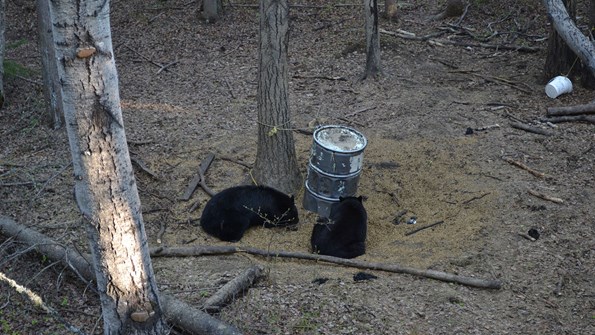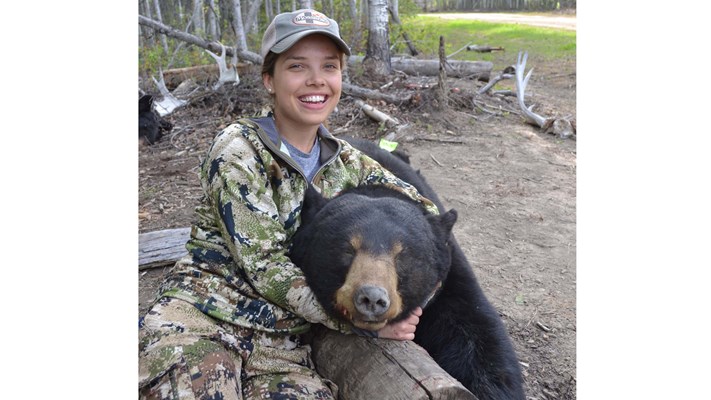
Black bears are one of the trickiest animals to accurately field-judge, but there are some simple tricks you can use to get a good sense of the animal’s size when you’re making the decision on whether or not to pull the trigger.
First, it’s important to understand that the definition of a “good bear” varies widely based on where you’re hunting. If you’re hunting locally, you’ll have a good idea of what’s average in your area. If you’re going on an out-of-state guided hunt, your outfitter can fill you in on what you can reasonably expect in the area you’ll be hunting. It’s up to you, and any legal bear you’re happy with is a good bear, but holding out for an 8-foot monster in a region where the average bear squares out at 5 feet is probably going to be an exercise in frustration.
Other considerations might come into play, too. If you’re looking to shoot a 6-foot bear but a 5-foot cinnamon bear presents an opportunity, and you’ve always wanted to shoot a color-phase bear, go for it. If you like it, it’s a good bear!
The time of year matters, too. Early spring bears will be thinner than fall bears, as they’ve just emerged from hibernation and have burned off much of their winter fat stores. Fall bears have been gorging all summer and will be fatter than they were just a few months ago.
Bears are properly measured by measuring the fleshed hide nose to tail and claw to claw across the shoulders. Add those two measurements and divide by two—this is called “squaring” the hide. Record books like Boone & Crockett use the measurements of the skull to determine bear size, but skull size is even harder to judge in the field than body size. Weight is a factor in bear size as well, of course, particularly if you’re primarily a meat hunter, but not all of us have an easy way to weigh a bear, and the weight can vary widely based on the time of year, as mentioned above.
All things considered, a mature boar will be bigger than a mature sow; you can tell them apart by dominance behavior (a boar is more likely to scratch his back on a tree, break limbs and chase other bears around) and by looking for the penile sheath when the bear stands up.
Compare If You Can
One of the more reliable ways to judge a bear is to compare him to another object of known size. If you’re hunting over bait, you’ll be able to compare him to the bait barrel or a hanging honey pot. In the last place I hunted bears (Alberta), a bear whose back was level with the top ring on the 55-gallon bait barrel was considered good enough to shoot. A bear who was a bit taller than that was a nice bear, and if his back was level with the top of the barrel, he was a great bear. If you are hunting where you can see a suspended bait or hanging bait pot, make sure you know how high it is off the ground. When a bear stands up to reach the bait, you’ll be able to tell how tall he is. Even knowing how tall some of the bushes or trees near your stand are will help give you a size reference. If you’re spot-and-stalk hunting, being familiar with the average circumference of different trees in your region will at least give you some kind of comparison point.

Hunting over bait makes field-judging easier, because the barrel provides a handy comparison tool. Both of these bears were about as tall as the top ring of the barrel—decent, but not good enough to shoot on the first night of a hunt in the region I was in.
Body Size Tips
If you have no barrel or other frame of reference to judge a bear’s size, look at his body. Are his legs long, with lots of daylight under his belly? He’s on the smaller side, or at least he’s thin. A trophy bear will have a lower, saggy belly, especially in the fall and early winter. His legs will look a little short by comparison.
Next, look at his ears—where do they sit in relation to his head? If they’re on top of his head or just slightly off to the side, he’s young and still small. If they’re farther off to the side at 2 o’clock and 10 o’clock, particularly when he’s looking at you or intently focusing on something, that’s a good indication that he’s a nice bear. The smaller the ears in relation to the size of the head, the better the bear, usually.
That said, a trophy bear might have a head that looks small for his big body. Many big bears have a noticeable crease down their forehead, but not all do, so don’t let the lack of a crease convince you a bear is small if there are other signs telling you he might be a shooter. I don’t have the space to show you a bunch of pictures here, but spend some time googling photos of black bears and look at the differences in sizes. You’ll quickly see what that saggy belly and to-the-side ears look like.

This bear measured in excess of 7 feet—a trophy bear just about anywhere. Note the crease in his forehead and the placement of his ears out to the side of his head.
Use Scat as a Clue
If you’re tracking a bear or checking a bait every night, you might come across a pile of scat. This can tell you a lot about a bear’s size, believe it or not. A very experienced bear hunter once told me to look for scat that’s as big around as a Coke can. Big bears leave big poop!
Behavior Is a Clue
You can judge a bear by his behavior and attitude. Big bears will drive away or even eat smaller bears, and the biggest bear in the area will act like the boss—because he is. He swaggers around like he owns the place. Depending on hunting pressure in the area, he’ll probably be less cagey than the other bears you’ve seen, because he’s not afraid of getting pushed around by anything. He’ll dominate a bait at prime feeding time if he wants to, chasing other bears off. The dominant bear in the area is usually the biggest, and he rules the roost—and he’ll act like it.
A smaller bear will be more skittish and sneaky, because he has to live looking over his shoulder to avoid the dominant bear. Watch how the bear approaches the bait. Is he confident? Or does he act skittish, like he doesn’t want to get caught? The confident bear is the shooter. If you’re watching a bear feeding and he suddenly gets spooked and bolts for seemingly no reason, get ready. Mr. Big might be about to walk out.














































